Numerical Analysis of the Impact Resistance of Composite A-Shaped Sandwich Structures
Abstract
:1. Introduction
2. Theoretical Background
3. Numerical Model Building
4. Analysis of Results and Discussion
4.1. Ballistic Limit Velocity
4.1.1. Verification of the Ballistic Limit Velocity Model
4.1.2. Comparison of the Ballistic Limit Velocity of A-Shaped Sandwich Structures and Y-Shaped Sandwich Structures
4.2. Failure Mode
4.2.1. Failure Mode Verification of Structures
4.2.2. Impact Damage Process for the Composite A-Shaped Core Sandwich Structures
4.2.3. Damage to the Face Sheet, Rear Sheet, and A-Shaped Core
4.3. Numerical Simulation of the Impact Position
5. Conclusions
Author Contributions
Funding
Institutional Review Board Statement
Informed Consent Statement
Data Availability Statement
Conflicts of Interest
References
- Liu, K.; Zong, S.; Li, Y.; Wang, Z.; Hu, Z.; Wang, Z. Structural response of the U-type corrugated core sandwich panel used in ship structures under the lateral quasi-static compression load. Mar. Struct. 2022, 84, 103198. [Google Scholar]
- Yan, L.; Yu, B.; Han, B.; Zhang, Q.; Lu, T.; Lu, B. Effects of aluminum foam filling on the low-velocity impact response of sandwich panels with corrugated cores. J. Sandw. Struct. Mater. 2020, 22, 929–947. [Google Scholar] [CrossRef]
- He, W.; Liu, J.; Wang, S.; Xie, D. Low-velocity impact behavior of X-Frame core sandwich structures–experimental and numerical investigation. Thin-Walled Struct. 2018, 131, 718–735. [Google Scholar]
- Cui, Z.; Qi, J.; Duan, Y.; Tie, Y.; Zheng, Y.; Yang, J.; Li, C. Low-Velocity Impact Resistance of 3D Re-Entrant Honeycomb Sandwich Structures with CFRP Face Sheets. Polymers 2023, 15, 1092. [Google Scholar] [CrossRef] [PubMed]
- Zhang, Y.; Liu, X.; Zhou, Y.; Shi, Y. Uniaxial compressive performance of an aramid and aluminum honeycomb sandwich structure. Ocean. Eng. 2023, 270, 113676. [Google Scholar] [CrossRef]
- Kueh, A.B.H.; Tan, J.H.; Abu Hassan, S.; Wahit, M.U. Repeated impact response of bio-inspired sandwich beam with arched and honeycomb bilayer core. Struct. Eng. Mech. 2023, 85, 755–764. [Google Scholar] [CrossRef]
- Xiong, J.; Ma, L.; Stocchi, A.; Yang, J.; Wu, L.; Pan, S. Bending response of carbon fiber composite sandwich beams with three dimensional honeycomb cores. Compos. Struct. 2014, 108, 234–242. [Google Scholar]
- Xiong, J.; Ma, L.; Pan, S.; Wu, L.; Papadopoulos, J.; Vaziri, A. Shear and bending performance of carbon fiber composite sandwich panels with pyramidal truss cores. Acta Mater. 2012, 60, 1455–1466. [Google Scholar] [CrossRef]
- Yang, J.S.; Chen, S.Y.; Li, S.; Pang, Y.Z.; Schmidt, R.; Schröder, K.U.; Qu, J.; Wu, L.Z. Dynamic responses of hybrid lightweight composite sandwich panels with aluminium pyramidal truss cores. J. Sandw. Struct. Mater. 2021, 23, 2176–2195. [Google Scholar]
- Xiong, J.; Ma, L.; Wu, L.; Wang, B.; Vaziri, A. Fabrication and crushing behavior of low density carbon fiber composite pyramidal truss structures. Compos. Struct. 2010, 92, 2695–2702. [Google Scholar] [CrossRef]
- Wu, Q.; Ma, L.; Wu, L.; Xiong, J. A novel strengthening method for carbon fiber composite lattice truss structures. Compos. Struct. 2016, 153, 585–592. [Google Scholar]
- Qi, G.; Ji, B.; Ma, L. Mechanical response of pyramidal lattice truss core sandwich structures by additive manufacturing. Mech. Adv. Mater. Struct. 2019, 26, 1298–1306. [Google Scholar] [CrossRef]
- Guin, W.E.; Nettles, A.T. Effects of core splice joint width on the performance of composite sandwich structures with honeycomb core: An experimental study. J. Sandw. Struct. Mater. 2022, 24, 720–741. [Google Scholar] [CrossRef]
- Daliri, V.; Zeinedini, A. Flexural behavoiur of the composite sandwich panels with novel and regular corrugated cores. Appl. Compos. Mater. 2019, 26, 963–982. [Google Scholar] [CrossRef]
- Ren, Y.; Wang, N.; Jiang, H.; Liu, Z. Numerical evaluation of planar compression performances of composite sandwich panel with X-, Y-, and A-shaped core. J. Compos. Mater. 2021, 55, 1835–1849. [Google Scholar] [CrossRef]
- A, X.C.; B, H.H. Acoustic responses of the composite sandwich plates with lattice truss core to the subsonic turbulent boundary layer. Compos. Struct. 2016, 153, 176–192. [Google Scholar]
- Zhang, G.; Wang, H.; Liu, Q.; Liu, Z. Impact resistance of composite circular corrugated core sandwich structures. J. Compos. Mater. 2023, 57, 967–988. [Google Scholar] [CrossRef]
- Zhao, T.; Jiang, Y.; Zhu, Y.; Wan, Z.; Xiao, D.; Li, Y.; Li, H.; Wu, C.; Fang, D. An experimental investigation on low-velocity impact response of a novel corrugated sandwiched composite structure. Compos. Struct. 2020, 252, 112676. [Google Scholar]
- Yu, S.; Yu, X.; Ao, Y.; Mei, J.; Jiang, W.; Liu, J.; Li, C.; Huang, W. The impact resistance of composite Y-shaped cores sandwich structure. Thin-Walled Struct. 2021, 169, 108389. [Google Scholar]
- Christensen, R.M. 2013 Timoshenko Medal Award Paper—Completion and Closure on Failure Criteria for Unidirectional Fiber Composite Materials. J. Appl. Mech. 2014, 81, 011011. [Google Scholar] [CrossRef]
- Zhang, G.; Wang, B.; Ma, L.; Xiong, J.; Wu, L. Response of sandwich structures with pyramidal truss cores under the compression and impact loading. Compos. Struct. 2013, 100, 451–463. [Google Scholar] [CrossRef]
- Li, S.; Yang, J.S.; Schmidt, R.; Wu, L.Z.; Schröder, K.U. Compression and hysteresis responses of multilayer gradient composite lattice sandwich panels. Mar. Struct. 2021, 75, 102845. [Google Scholar] [CrossRef]
- Mei, J.; Ao, Y.; Jiang, W.; Liu, J.; Zhou, Z.; Huang, W. Investigation on the shear behaviors of carbon fiber composite sandwich panels with the X-core. Mar. Struct. 2021, 77, 102897. [Google Scholar] [CrossRef]
- Liu, J.; Liu, J.; Mei, J.; Huang, W. Investigation on manufacturing and mechanical behavior of all-composite sandwich structure with Y-shaped cores. Compos. Sci. Technol. 2018, 159, 87–102. [Google Scholar] [CrossRef]
- ASTM International. Standard Practice for Determining Sandwich Beam Flexural and Shear Stiffness; ASTM International: West Conshohocken, PA, USA, 2012. [Google Scholar]
- Shakil, U.A.; Hassan, S.B.A.; Yahya, M.Y.; Nurhadiyanto, D. A review of properties and fabrication techniques of fiber reinforced polymer nanocomposites subjected to simulated accidental ballistic impact. Thin-Walled Struct. 2021, 158, 107150. [Google Scholar]
- Hu, P.; Cheng, Y.; Zhang, P.; Liu, J.; Yang, H.; Chen, J. A metal/UHMWPE/SiC multi-layered composite armor against ballistic impact of flat-nosed projectile. Ceram. Int. 2021, 47, 22497–22513. [Google Scholar]
- Zhikharev, M.; Sapozhnikov, S. Two-scale modeling of high-velocity fragment GFRP penetration for assessment of ballistic limit. Int. J. Impact Eng. 2017, 101, 42–48. [Google Scholar] [CrossRef]
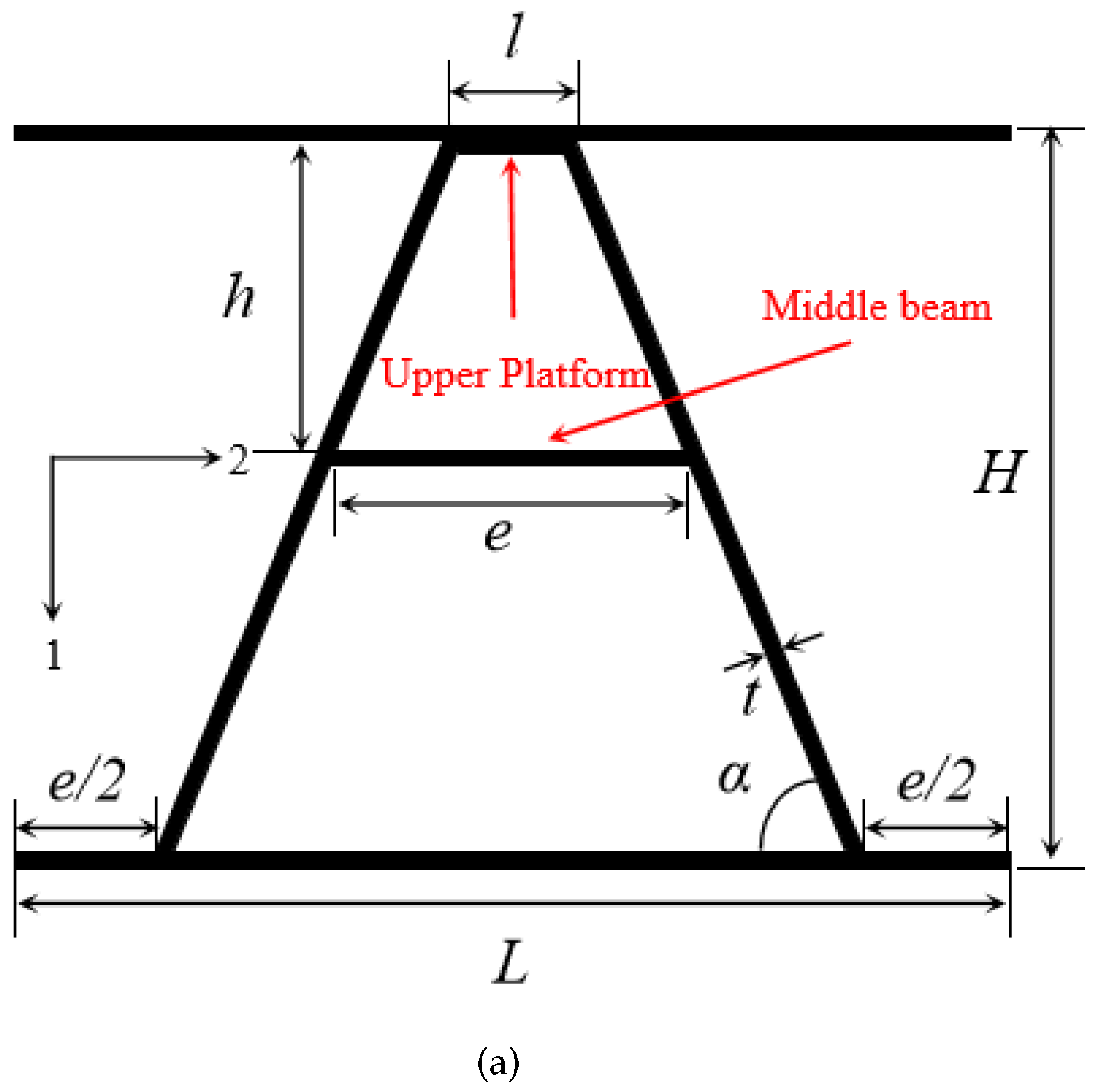
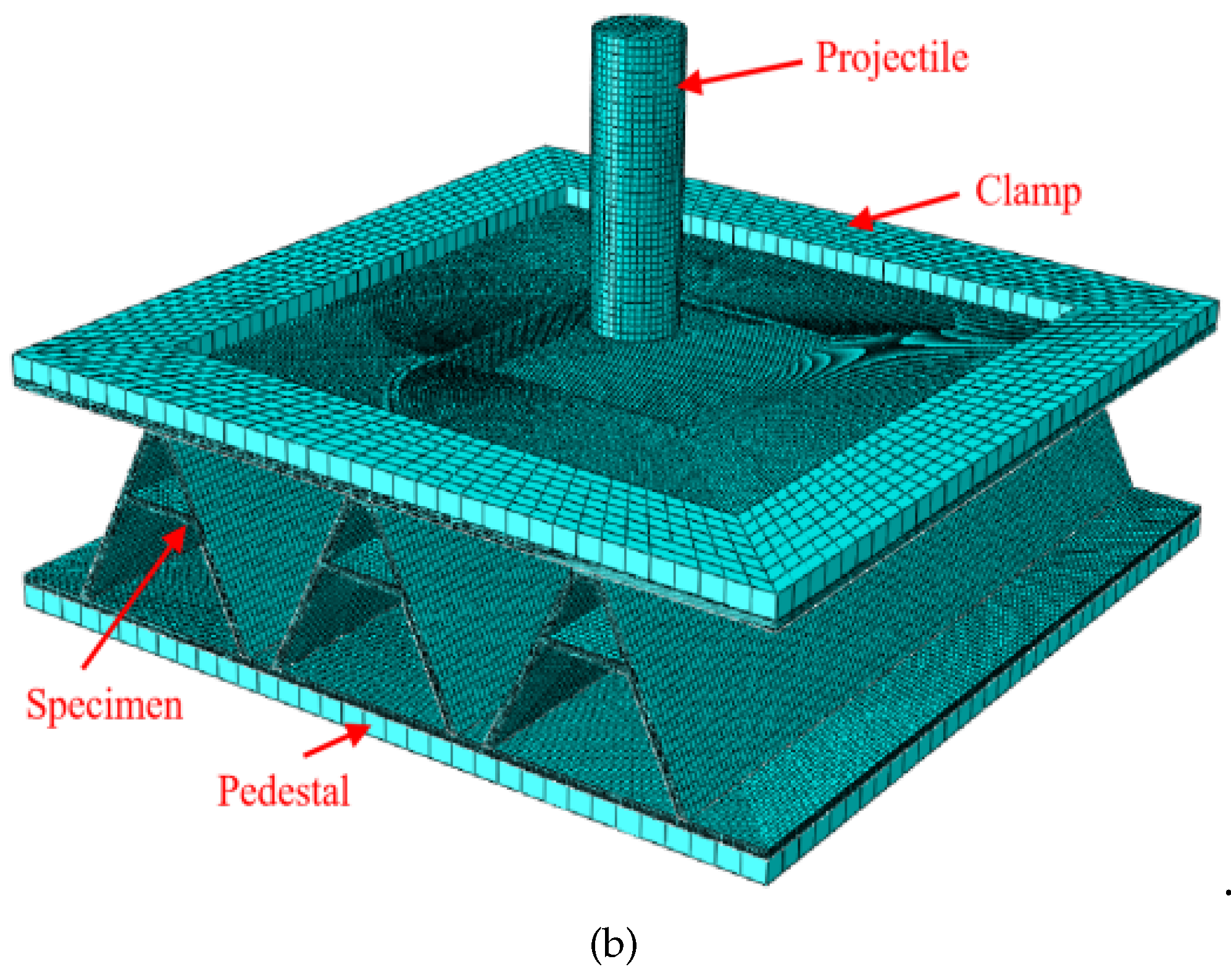
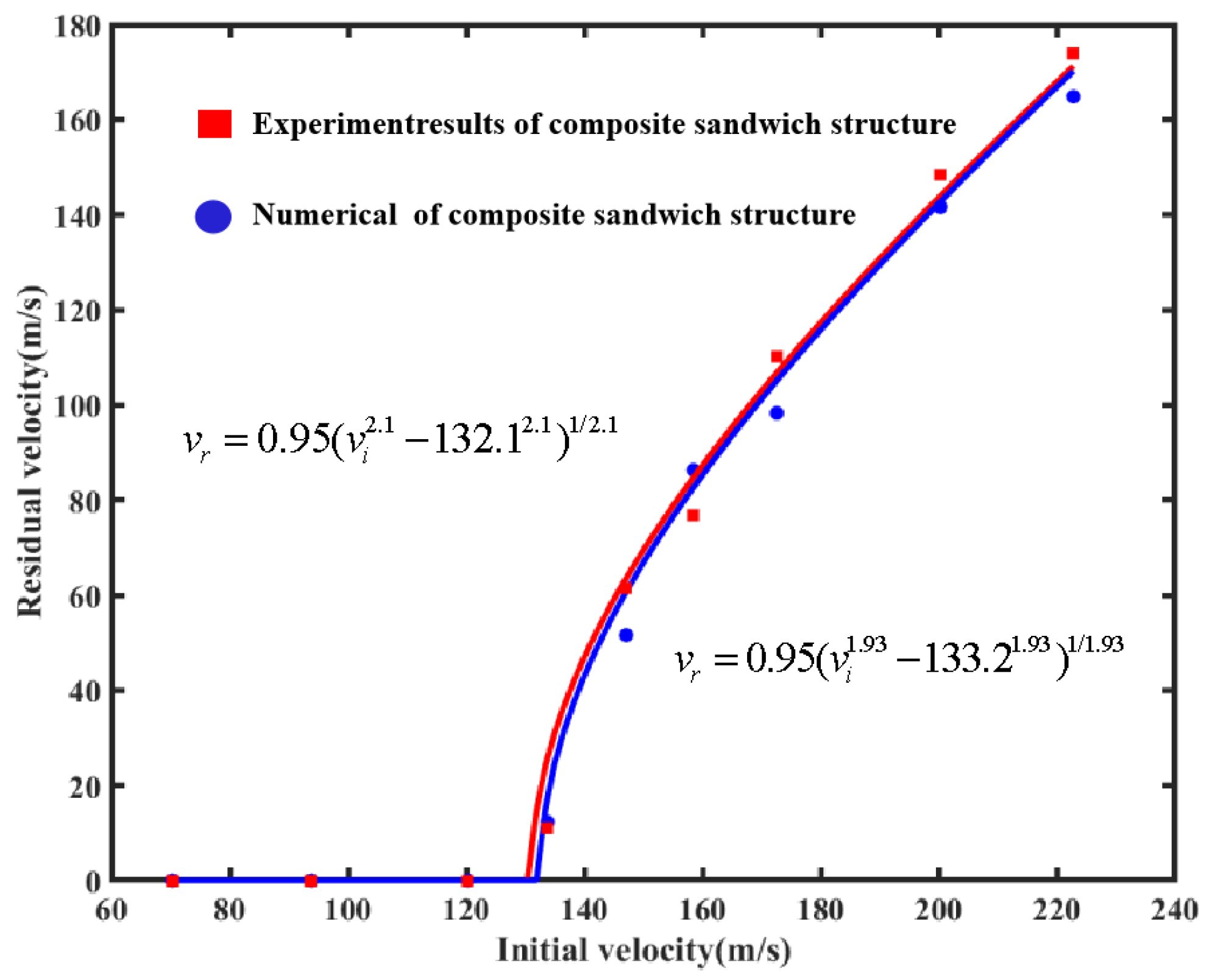

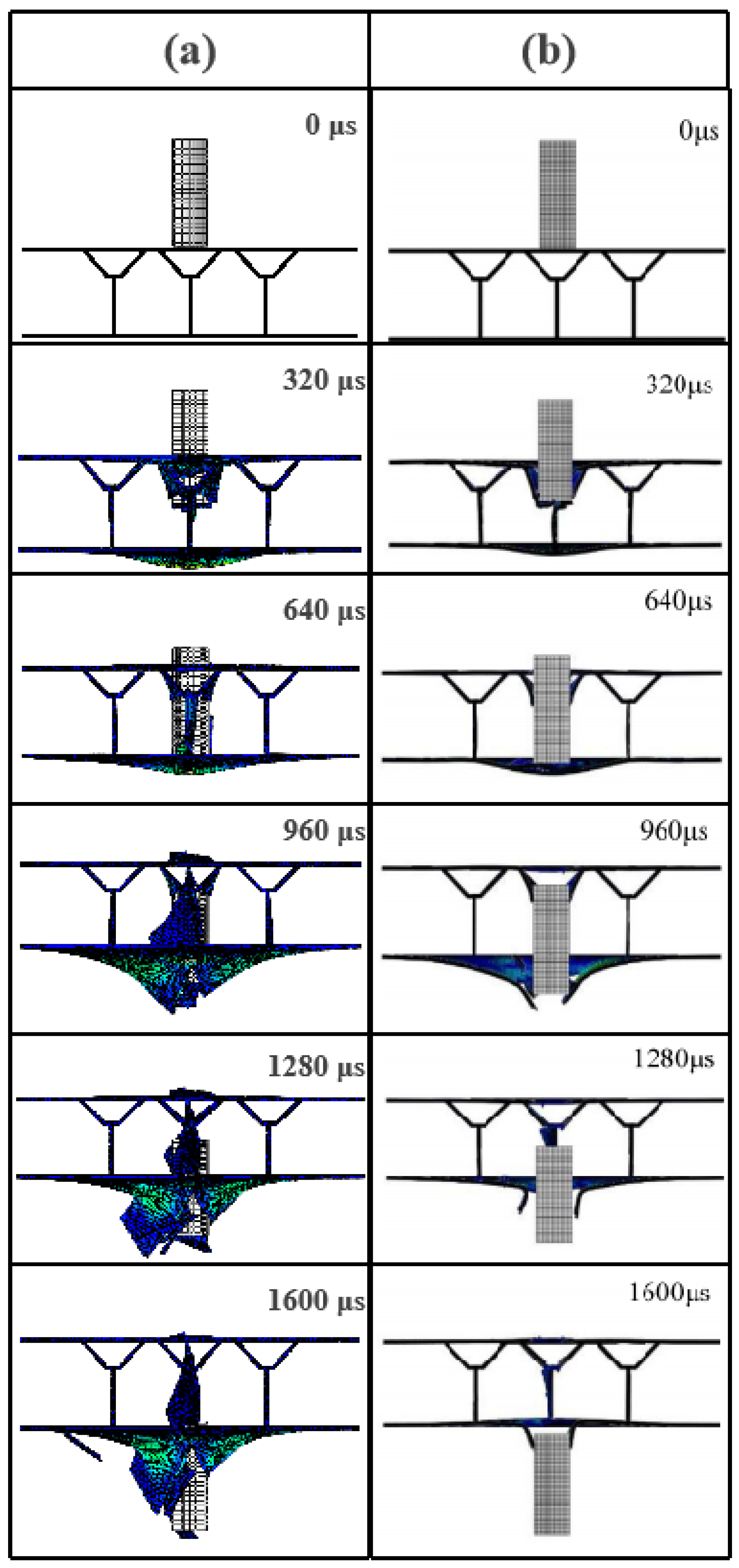



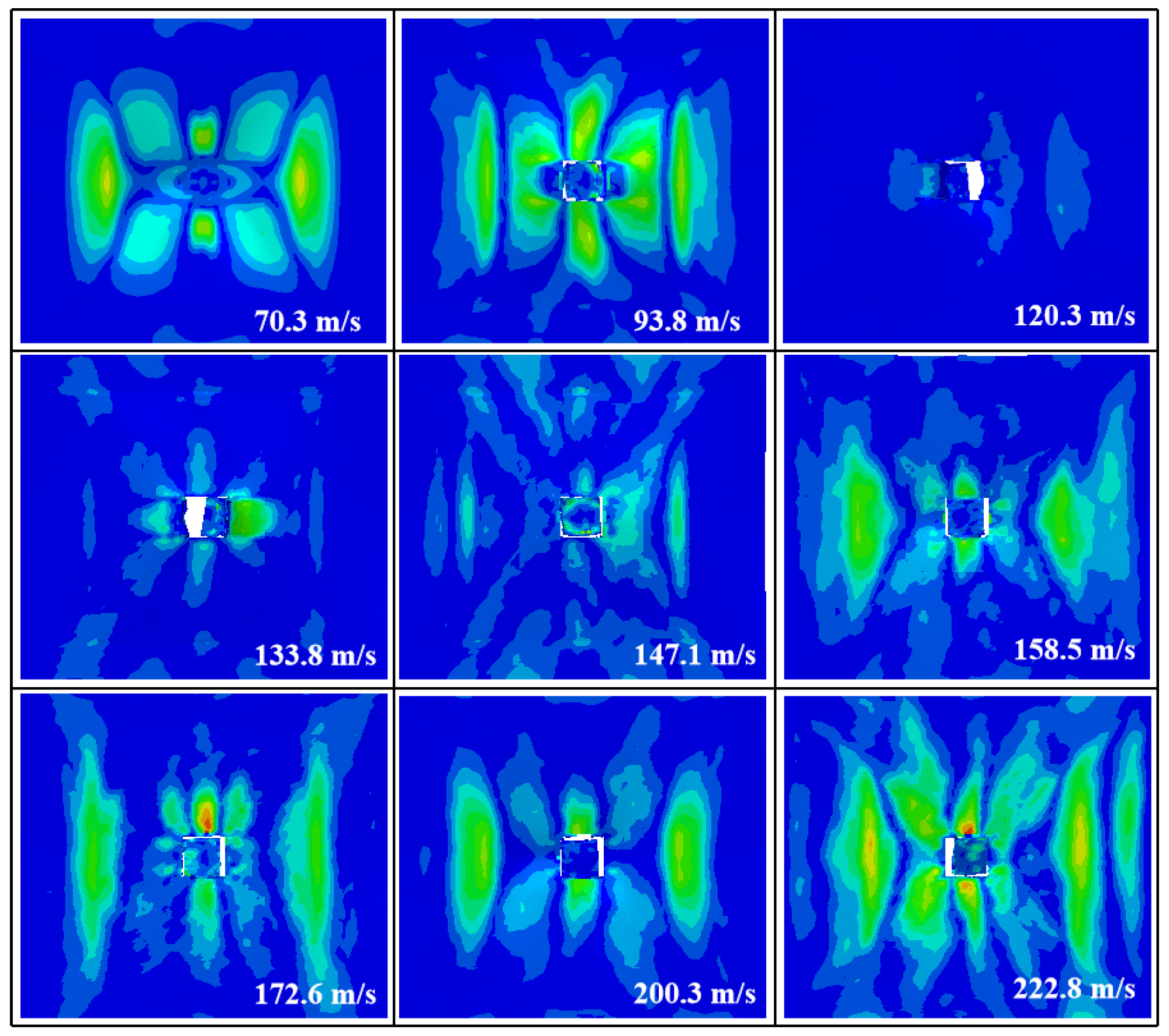
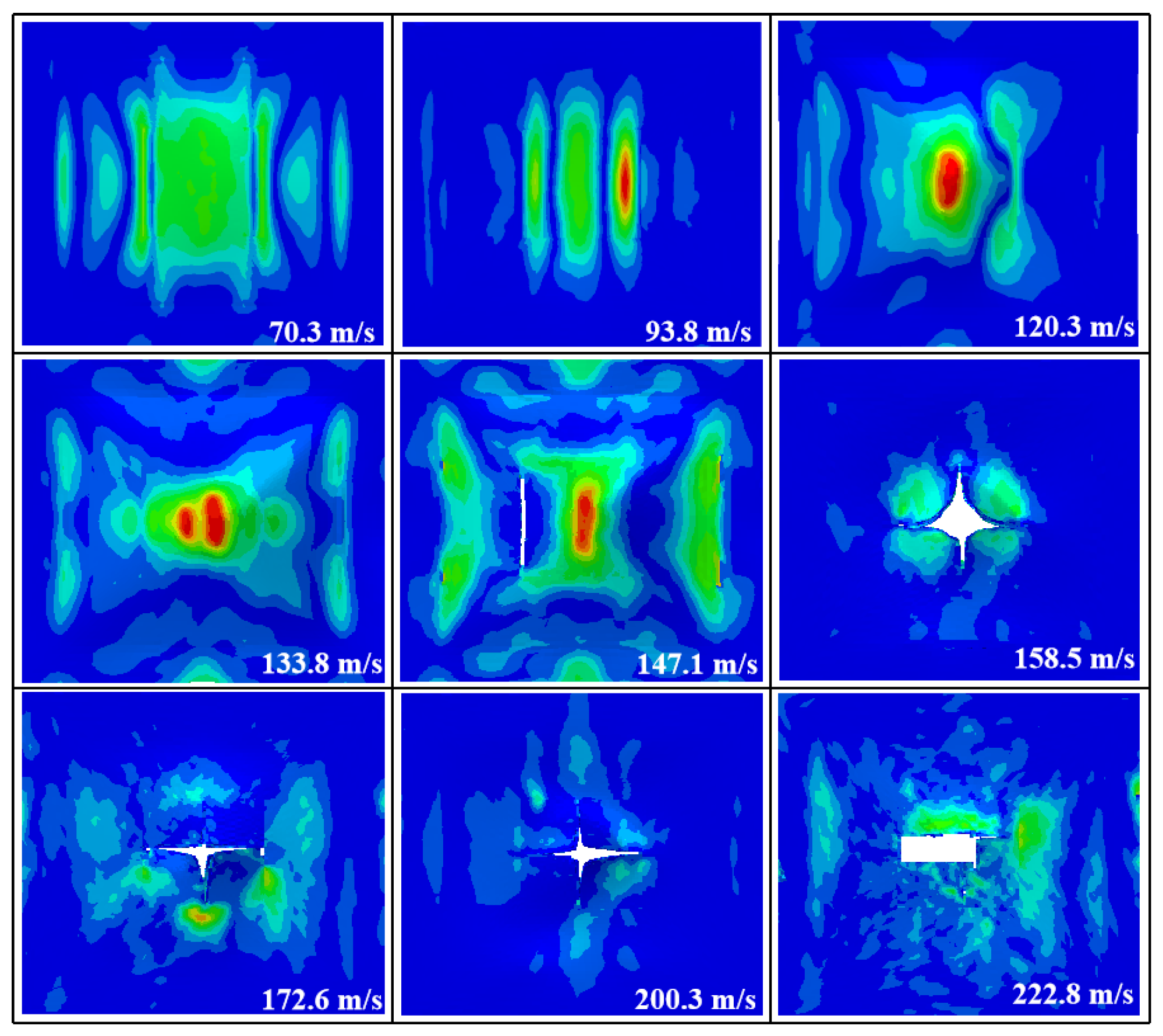
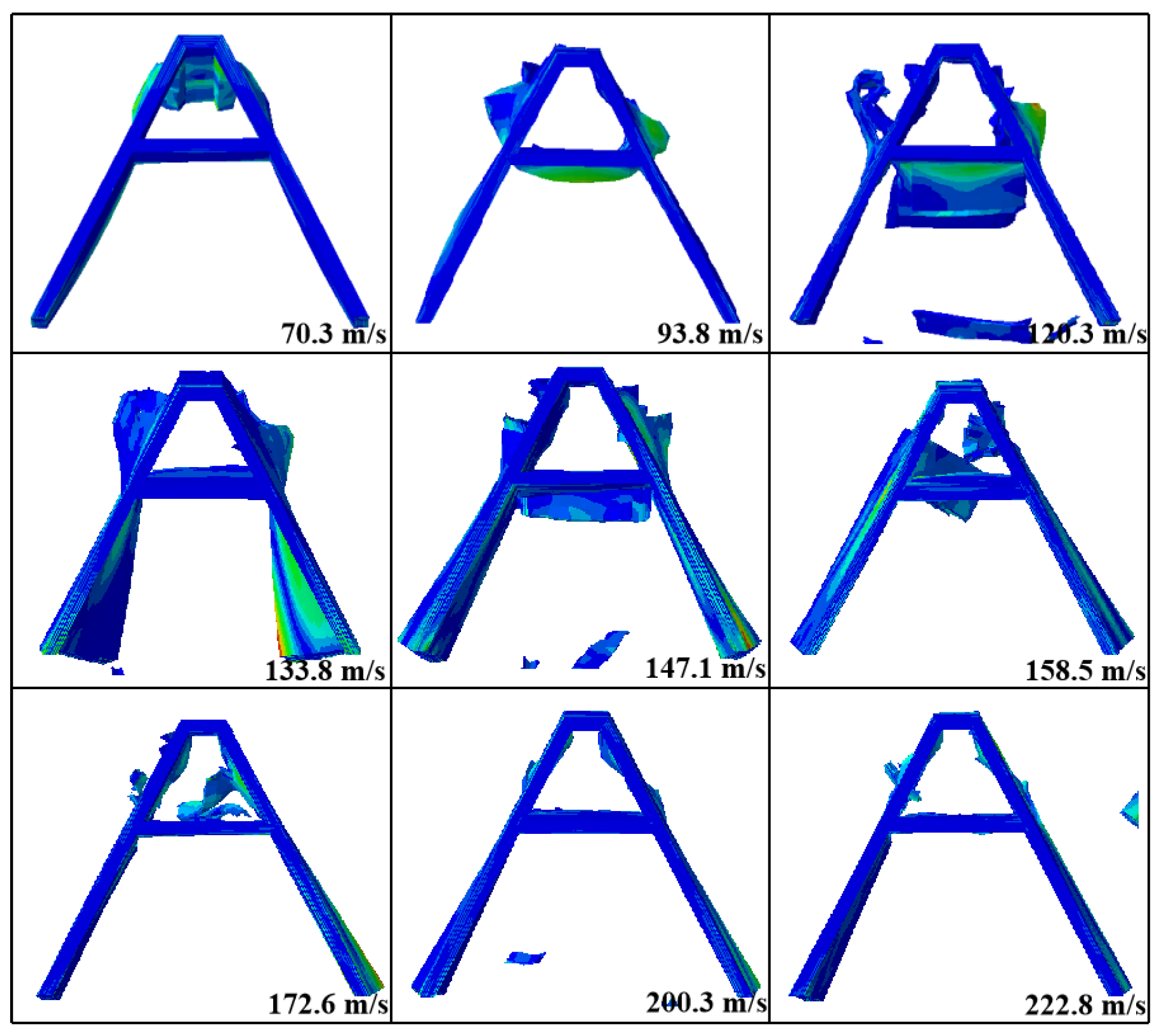
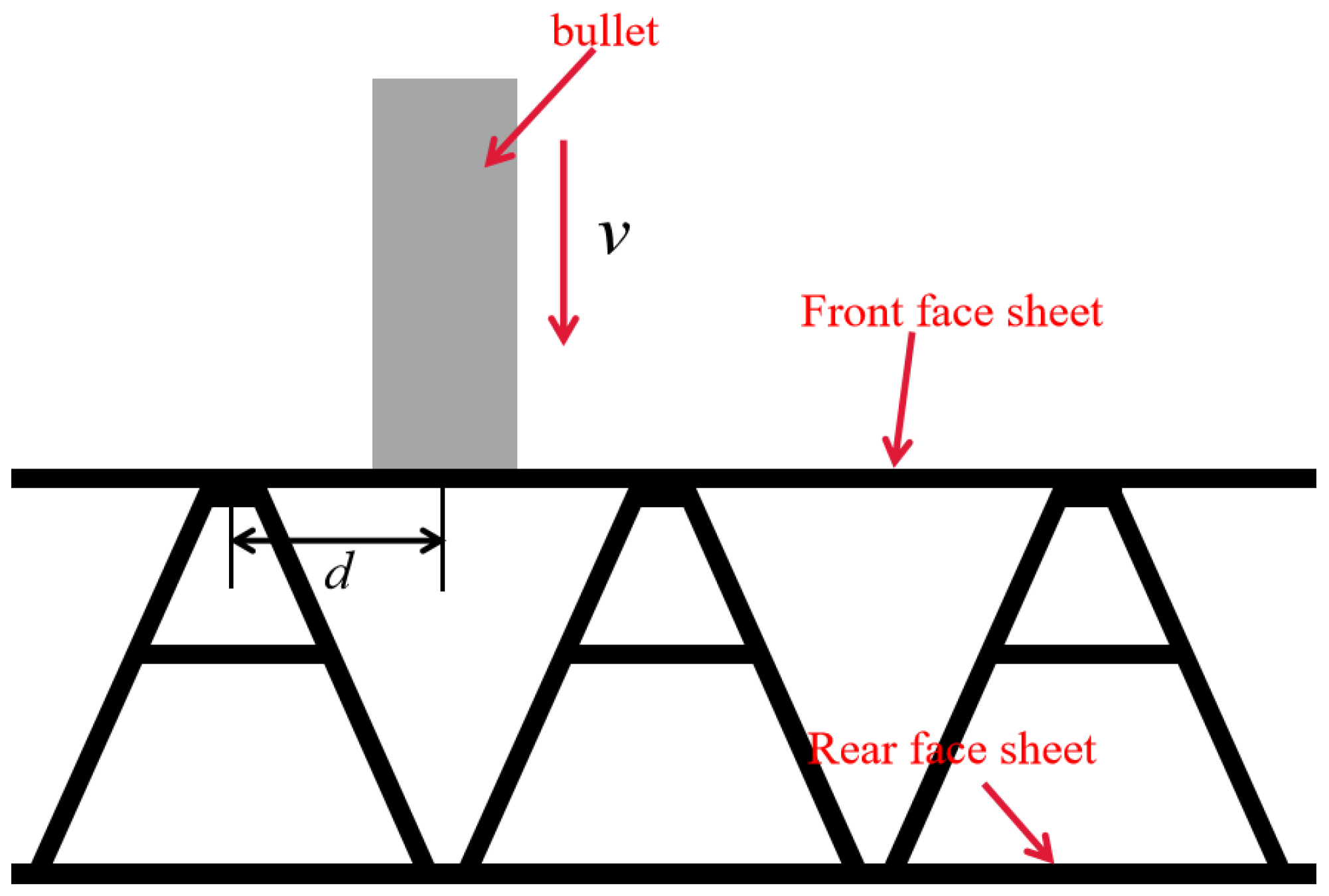

| Category | Symbol | Value |
|---|---|---|
| Upper platform (mm) | l | 4.1 |
| Mid-platform (mm) | e | 10.4 |
| Height of middle beam (mm) | h | 9.0 |
| Overall height of the sandwich structure (mm) | H | 27.0 |
| Thickness (mm) | t | 1.2 |
| Inclined angle of legs () | 60 |
| Category | Symbol | Value |
|---|---|---|
| Longitudinal modulus (MPa) | 100,000 | |
| Transverse modulus (MPa) | 8000 | |
| Out-of-plane modulus (MPa) | 8000 | |
| Poisson’s ratio | 0.21, 0.21, 0.3 | |
| Shear modulus (MPa) | 0.21, 0.21, 0.3 | |
| Shear strength (MPa) | 104, 104, 86 | |
| Longitudinal tensile strength (MPa) | 2100 | |
| Longitudinal compressive strength (MPa) | 700 | |
| Transverse tensile strength (MPa) | 42 | |
| Transverse compressive strength (MPa) | 160 | |
| Out-of-plane tensile strength (MPa) | 42 | |
| Out-of-plane compressive strength (MPa) | 1600 | |
| Density (kg/m) | 1500 |
| Test Group | Experimental Results of Composite Sandwich Structure [19] | Numerical Results of Composite Sandwich Structure | Error (%) | ||
|---|---|---|---|---|---|
| (m/s) | (m/s) | (m/s) | (m/s) | ||
| 1 | 70.3 | – | 70.3 | – | - |
| 2 | 93.8 | – | 93.8 | – | - |
| 3 | 120.3 | – | 120.3 | – | - |
| 4 | 133.8 | 12.3 | 133.8 | 10.9 | 11.38 |
| 5 | 147.1 | 51.6 | 147.1 | 61.4 | 18.99 |
| 6 | 158.5 | 86.3 | 158.5 | 76.7 | 11.12 |
| 7 | 172.6 | 98.3 | 172.6 | 110.1 | 12 |
| 8 | 200.3 | 141.6 | 200.3 | 148.4 | 4.8 |
| 9 | 222.8 | 164.8 | 222.8 | 174.3 | 5.76 |
| Test Group | Numerical Results of the Composite Y-Shaped Core Sandwich Structure | Numerical Results of the Composite A-Shaped Core Sandwich Structure | ||
|---|---|---|---|---|
| (m/s) | (m/s) | (m/s) | (m/s) | |
| 1 | 70.3 | 0 | 70.3 | 0 |
| 2 | 93.8 | 0 | 93.8 | 0 |
| 3 | 120.3 | 0 | 120.3 | 0 |
| 4 | 133.8 | 14.3 | 133.8 | 0 |
| 5 | 147.1 | 58.1 | 147.1 | 0 |
| 6 | 158.5 | 97.2 | 158.5 | 60.7 |
| 7 | 172.6 | 109.2 | 172.6 | 103.3 |
| 8 | 200.3 | 155.3 | 200.3 | 140.6 |
| 9 | 222.8 | 173.4 | 222.8 | 165.4 |
Disclaimer/Publisher’s Note: The statements, opinions and data contained in all publications are solely those of the individual author(s) and contributor(s) and not of MDPI and/or the editor(s). MDPI and/or the editor(s) disclaim responsibility for any injury to people or property resulting from any ideas, methods, instructions or products referred to in the content. |
© 2023 by the authors. Licensee MDPI, Basel, Switzerland. This article is an open access article distributed under the terms and conditions of the Creative Commons Attribution (CC BY) license (https://creativecommons.org/licenses/by/4.0/).
Share and Cite
Gu, X.; Li, J.; Huang, J.; Ao, Y.; Zhao, B. Numerical Analysis of the Impact Resistance of Composite A-Shaped Sandwich Structures. Materials 2023, 16, 5031. https://doi.org/10.3390/ma16145031
Gu X, Li J, Huang J, Ao Y, Zhao B. Numerical Analysis of the Impact Resistance of Composite A-Shaped Sandwich Structures. Materials. 2023; 16(14):5031. https://doi.org/10.3390/ma16145031
Chicago/Turabian StyleGu, Xuetao, Jiawen Li, Ji Huang, Yaoliang Ao, and Bingxiong Zhao. 2023. "Numerical Analysis of the Impact Resistance of Composite A-Shaped Sandwich Structures" Materials 16, no. 14: 5031. https://doi.org/10.3390/ma16145031
APA StyleGu, X., Li, J., Huang, J., Ao, Y., & Zhao, B. (2023). Numerical Analysis of the Impact Resistance of Composite A-Shaped Sandwich Structures. Materials, 16(14), 5031. https://doi.org/10.3390/ma16145031






